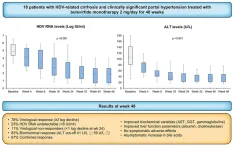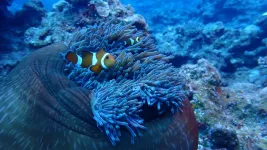(Press-News.org) AAV is a multi-organ disease, which can be complex and may vary from person to person. Types of AAV include granulomatosis with polyangiitis (GPA), microscopic polyangiitis (MPA), and eosinophilic granulomatosis with polyangiitis (EGPA). This variety can make management challenging. Comorbidities, an individual’s history, toxicities, medication availability and cost, and patient preferences should all be considered in the process of informed decision making.
EULAR first wrote recommendations for small and medium vessel vasculitis in 2009; this was subsequently updated in 2016 with more of a focus on AAV. The new 2022 update includes substantial alterations, including the introduction of overarching principles and new recommendations on ANCA-testing, glucocorticoid treatment, the use of agents with novel modes of action, and preventative measures against infection. In addition, new data has allowed the development of some separate recommendations for people with specific AAV subtypes – namely GPA, MPA, and EGPA.
The updated EULAR recommendations were developed by a multidisciplinary task force that included rheumatologists, internists, nephrologists, and methodologists, as well as patient representatives. The information is based on evidence collected from the literature and a survey among the task force members.
The new paper developed by EULAR and published in the March 2023issue of the Annals of the Rheumatic Diseases includes 4 overarching principles and 17 recommendations. The principles say that people with AAV should be offered best care based on shared decision making between the patient and the physician. People with AAV should have access to education so that they understand the impact of their disease, and be able to recognize key symptoms and complications. They also recommend that people with AAV be screened for treatment-related adverse effects and comorbidities, and offered appropriate preventative treatment or lifestyle advice. Finally, the overarching principles stress that AAV are rare, heterogeneous, and potentially life-and organ-threatening diseases which require multidisciplinary management that includes vasculitis experts. The individual recommendations outline the various treatment options for people to induce and maintain remission, depending on their specific diagnosis and manifestations.
One additional key element of these updated recommendations is inclusion of definition of disease activity states. These can vary between different clinical trials, but EULAR recommend these consensus definitions to further understanding and make it easier to compare results. This includes definitions of active disease, remission, relapse, and refractory disease.
EULAR believes that these recommendations will help to streamline the management of people with AAV – while they are not intended to be used as a one-size-fits-all strategy, and may need to be used alongside other recommendations and treatment algorithms, depending on each person’s disease, manifestations, and comorbidities. It is hoped these recommendations will be incorporated into everyday clinical practice to effectively manage AAV and to improve quality of care.
Source
Hellmich B, Sanchez-Alamo B, Schirmer JH, et al. EULAR recommendations for the management of ANCA-associated vasculitis: 2022 update. Annals of the Rheumatic Diseases Published Online First: 16 March 2023. doi: 10.1136/ard-2022-223764
About EULAR
EULAR is the European umbrella organisation representing scientific societies, health professional associations and organisations for people with rheumatic and musculoskeletal diseases (RMDs). EULAR aims to reduce the impact of RMDs on individuals and society, as well as improve RMD treatments, prevention, and rehabilitation. To this end, EULAR fosters excellence in rheumatology education and research, promotes the translation of research advances into daily care, and advocates for the recognition of the needs of those living with RMDs by EU institutions.
Contact
EULAR Communications, communications@eular.org
Notes to Editors
EULAR Recommendations
EULAR School of Rheumatology
EULAR Press Releases
END
Updated: AAV Treatment Recommendations
2022 update published in the Annals of the Rheumatic Diseases
2023-03-20
ELSE PRESS RELEASES FROM THIS DATE:
Real-world studies confirm effectiveness of bulevirtide to treat chronic hepatitis D
2023-03-20
Amsterdam, March 20, 2023 – In 2020, bulevirtide (BLV) was conditionally approved for treating chronic hepatitis delta (CHD), an inflammation of the liver caused by hepatitis D virus (HDV). Now real-world studies of patients treated outside of clinical trials confirm that long-term suppressive therapy with BLV monotherapy has the potential to reduce viral replication and improve liver tests of these difficult-to-treat patients for the first time in 45 years, report investigators in the Journal of Hepatology and its companion journal JHEP Reports.
Two of the studies, led by Pietro Lampertico, MD, PhD, Division of Gastroenterology and Hepatology, Foundation IRCCS Ca’ ...
Ultrafast beam-steering breakthrough at Sandia Labs
2023-03-20
ALBUQUERQUE, N.M. — In a major breakthrough in the fields of nanophotonics and ultrafast optics, a Sandia National Laboratories research team has demonstrated the ability to dynamically steer light pulses from conventional, so-called incoherent light sources.
This ability to control light using a semiconductor device could allow low-power, relatively inexpensive sources like LEDs or flashlight bulbs to replace more powerful laser beams in new technologies such as holograms, remote sensing, self-driving cars and high-speed ...
New “traffic cop” algorithm helps a drone swarm stay on task
2023-03-20
How fresh are your data? For drones searching a disaster zone or robots inspecting a building, working with the freshest data is key to locating a survivor or reporting a potential hazard. But when multiple robots simultaneously relay time-sensitive information over a wireless network, a traffic jam of data can ensue. Any information that gets through is too stale to consider as a useful, real-time report.
Now, MIT engineers may have a solution. They’ve developed a method to tailor any wireless network to handle a high load of time-sensitive data coming from multiple sources. Their new approach, ...
Nanotechnology could treat lymphedema
2023-03-20
The human body is made up of thousands of tiny lymphatic vessels that ferry white blood cells and proteins around the body, like a superhighway of the immune system. It’s remarkably efficient, but if damaged from injury or cancer treatment, the whole system starts to fail. The resulting fluid retention and swelling, called lymphedema, isn’t just uncomfortable — it’s also irreversible.
When lymphatic vessels fail, typically their ability to pump out the fluid is compromised. Georgia Institute of Technology researchers have developed a new treatment using nanoparticles that can repair lymphatic vessel pumping. Traditionally, ...
Chicago Quantum Exchange Annual Report highlights 2022 growth
2023-03-20
The Chicago Quantum Exchange (CQE) continued to expand its diverse community of quantum researchers, leaders, and institutions in 2022—launching a quantum research fellowship for undergraduates, welcoming 11 new corporate partners, and extending a regional quantum communication network to a total length of 124 miles.
These are among the successes highlighted in the CQE’s newly published annual report, which chronicles the many contributions of the consortium’s members and partners and offers a window into the region’s ...
Jellyfish size might influence their nutritional value, UBC study finds
2023-03-20
Drifting along in ocean currents, jellyfish can be both predator and prey. They eat almost anything they can capture, and follow the typical oceanic pattern of large eats small. Now a recent University of British Columbia study on these gelatinous globs suggests jellyfish may get more nutritious as they get bigger.
As jellyfish grow, their size changes largely due to the chances of prey encounter, the length and number of tentacles, and their bells (the umbrella-like part of them). As a result, smaller jellyfish eat phytoplankton, microzooplankton, and eggs, while larger jellyfish can eat all of that plus shrimp and even fish. However, ...
What Darwin couldn’t see: Expedition to uncover invisible life in Galápagos
2023-03-20
An international research team led by the Netherlands Institute of Ecology (NIOO-KNAW) is to search for invisible life in the Galápagos Islands. The diversity of bacteria and other microscopic organisms may not be evident to the naked eye, but it is essential to nature. To the islands' giant daisies, for instance: unique endemic plants that are currently under threat.
How unique and diverse is the invisible microbial life of the iconic Galápagos Islands? That's what the Galápagos Microbiome Project - a group of scientists from the Netherlands, ...
In hot water: Ocean warming impacts growth, metabolic rate and gene activity of newly hatched clownfish
2023-03-20
Future ocean warming and marine heatwaves could impact the growth and development of clownfish during their earliest life stages, suggests a new study recently published in the journal, Science of The Total Environment.
A team of marine biologists from the Okinawa Institute of Science and Technology (OIST) reared the iconic coral reef fish in captivity at water temperatures of either 28°C or 31°C. Temperatures of 28°C represent current summer seawater temperatures in Okinawa, whilst temperatures of 31°C are reached during ...
Researchers study the impact of cancer on Hispanic patients and their caregivers
2023-03-20
Cancer, in all of its forms, is a public health concern responsible for more than 8 million deaths each year in the United States. In addition to its effect on patients and the health care system in general, cancer also places a burden on non-professional caregivers such as family members and friends. This can be especially true for the Hispanic population, where communication barriers, financial difficulties and sociocultural issues can be significant.
In a recently published review article, Jasbir ...
Workers' and bosses' trust in teleworking is key
2023-03-20
In recent years, teleworking – spurred by the implementation of information and communication technologies and the recent pandemic, particularly – has become a feature of many jobs. Many companies have now made this form of working available to their employees, but it is still far from common practice in today's labour market.
Universitat Oberta de Catalunya (UOC) researchers have analysed the different perspectives and perceptions on teleworking, looking at the wide range of ...
LAST 30 PRESS RELEASES:
Numbers in our sights affect how we perceive space
SIMJ announces global collaborative book project in commemoration of its 75th anniversary
Air pollution exposure and birth weight
Obstructive sleep apnea risk and mental health conditions among older adults
How talking slows eye movements behind the wheel
The Ceramic Society of Japan’s Oxoate Ceramics Research Association launches new international book project
Heart-brain connection: international study reveals the role of the vagus nerve in keeping the heart young
Researchers identify Rb1 as a predictive biomarker for a new therapeutic strategy in some breast cancers
Survey reveals ethical gaps slowing AI adoption in pediatric surgery
Stimulant ADHD medications work differently than thought
AI overestimates how smart people are, according to HSE economists
HSE researchers create genome-wide map of quadruplexes
Scientists boost cell "powerhouses" to burn more calories
Automatic label checking: The missing step in making reliable medical AI
Low daily alcohol intake linked to 50% heightened mouth cancer risk in India
American Meteorological Society announces Rick Spinrad as 2026 President-Elect
Biomass-based carbon capture spotlighted in newly released global climate webinar recording
Illuminating invisible nano pollutants: advanced bioimaging tracks the full journey of emerging nanoscale contaminants in living systems
How does age affect recovery from spinal cord injury?
Novel AI tool offers prognosis for patients with head and neck cancer
Fathers’ microplastic exposure tied to their children’s metabolic problems
Research validates laboratory model for studying high-grade serous ovarian cancer
SIR 2026 delivers transformative breakthroughs in minimally invasive medicine to improve patient care
Stem Cell Reports most downloaded papers of 2025 highlight the breadth and impact of stem cell research
Oxford-led study estimates NHS spends around 3% of its primary and secondary care budget on the health impacts of heat and cold in England
A researcher’s long quest leads to a smart composite breakthrough
Urban wild bees act as “microbial sensors” of city health.
New study finds where you live affects recovery after a hip fracture
Forecasting the impact of fully automated vehicle adoption on US road traffic injuries
Alcohol-related hospitalizations from 2016 to 2022
[Press-News.org] Updated: AAV Treatment Recommendations2022 update published in the Annals of the Rheumatic Diseases







